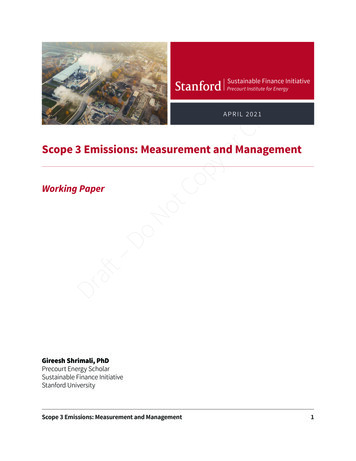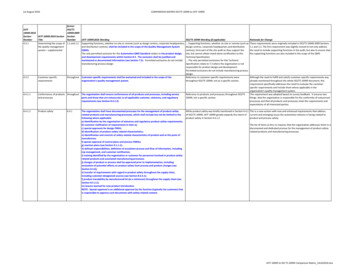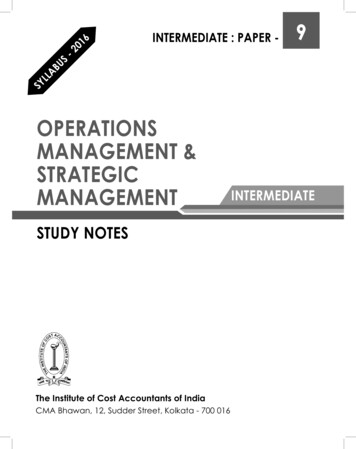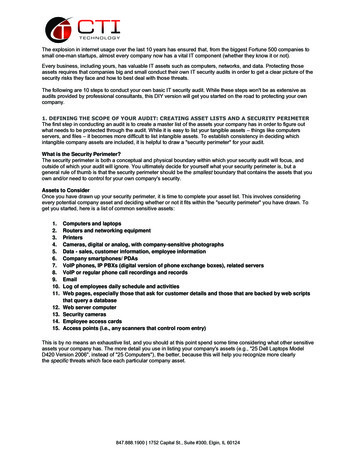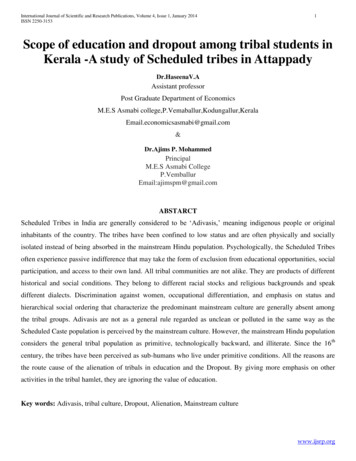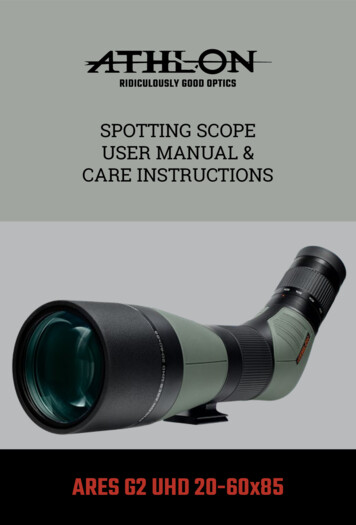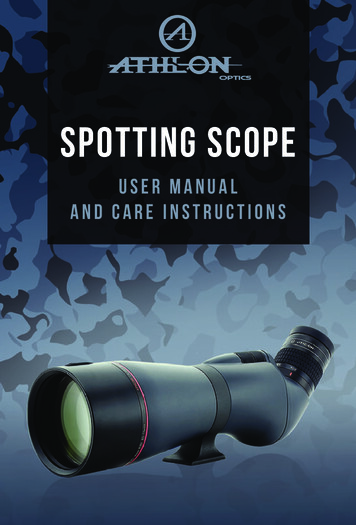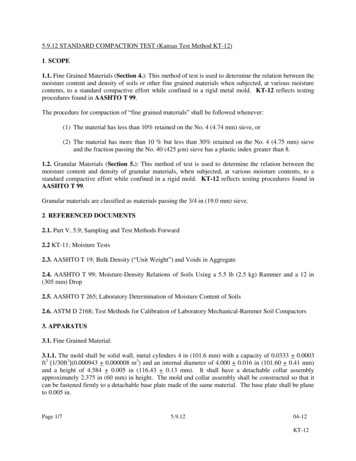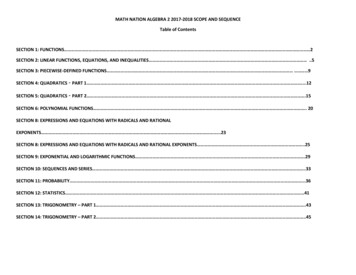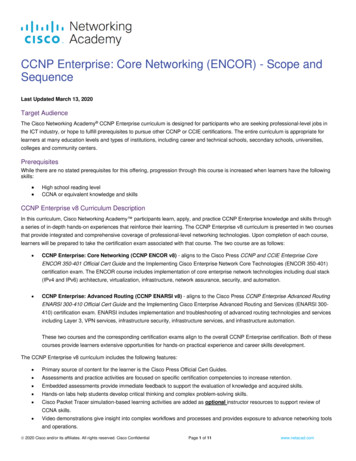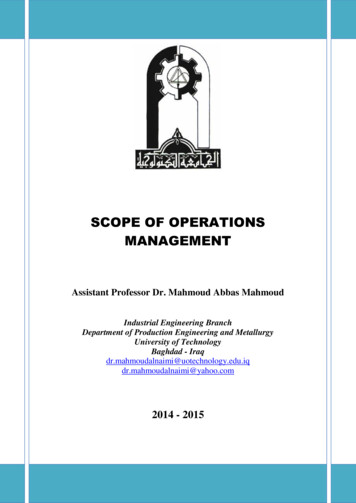
Transcription
SCOPE OF OPERATIONSMANAGEMENTAssistant Professor Dr. Mahmoud Abbas MahmoudIndustrial Engineering BranchDepartment of Production Engineering and MetallurgyUniversity of TechnologyBaghdad - dalnaimi@yahoo.com2014 - 2015
Production Planning and ControlDr. Mahmoud Abbas Mahmoud201 4 - 20151.1- CONCEPT OF PRODUCTIONProduction function is ‘the part of an organization, which is concernedwith the transformation of a range of inputs into the required outputs(products) having the requisite quality level’.Production is defined as ‘the step-by-step conversion of one form ofmaterial into another form through chemical or mechanical process tocreate or enhance the utility of the product to the user’. Thus productionis a value addition process. At each stage of processing, there will bevalue addition. Some examples of production are: manufacturing custommade products like, boilers with a specific capacity, constructing flats,some structural fabrication works for selected customers, etc., andmanufacturing standardized products like, car, bus, motor cycle, radio,television, etc.1.2- PRODUCTION SYSTEMThe production system is ‘that part of an organization, which producesproducts of an organization. It is that activity whereby resources, flowingwithin a defined system, are combined and transformed in a controlledmanner to add value in accordance with the policies communicated bymanagement’. A simplified production system is shown below:Fig.1 Schematic production systemThe production system has the following characteristics:1. Production is an organized activity, so every production system has anobjective.2. The system transforms the various inputs to useful outputs.3. It does not operate in isolation from the other organization system.4. There exists a feedback about the activities, which is essential tocontrol and improve system performance.1
Production Planning and ControlDr. Mahmoud Abbas Mahmoud201 4 - 20151.3- SCOPE OF OPERATIONS MANAGEMENTOperations Management concern with the conversion of inputs intooutputs, using physical resources, so as to provide the desired utilities tothe customer while meeting the other organizational objectives ofeffectiveness, efficiency and adoptability. It distinguishes itself fromother functions such as personnel, marketing, finance, etc. by its primaryconcern for ‘conversion by using physical resources’.Following are the activities, which are listed under Production andOperations Management functions:1. Location of facilities.2. Plant layouts and Material Handling.3. Product Design.4. Process Design.5. Production Planning and Control.6. Quality Control.7. Materials Management.8. Maintenance Management.Fig. 2 Scope of production and operations management2
Production Planning and ControlDr. Mahmoud Abbas Mahmoud201 4 - 2015LOCATION OF FACILITIESLocation of facilities for operations is a long-term capacity decision,which involves a long-term commitment about the geographically staticfactors that affect a business organization. It is an important strategiclevel decision-making for an organization. It deals with the questionssuch as ‘where our main operations should be based?’The selection of location is a key-decision as large investment is made inbuilding plant and machinery. An improper location of plant may lead towaste of all the investments made in plant and machinery equipments.Hence, location of plant should be based on the company’s expansionplan and policy, diversification plan for the products, changing sources ofraw materials and many other factors. The purpose of the location studyis to find the optimal location that will results in the greatest advantage tothe organization.PLANT LAYOUT AND MATERIAL HANDLINGPlant layout refers to the physical arrangement of facilities. It is theconfiguration of departments, work centers and equipment in theconversion process. The overall objective of the plant layout is to designa physical arrangement that meets the required output quality andquantity most economically.According to James More ‘Plant layout is a plan of an optimumarrangement of facilities including personnel, operating equipment,storage space, material handling equipments and all other supportingservices along with the design of best structure to contain all thesefacilities’.‘Material Handling’ refers to the ‘moving of materials from the storeroom to the machine and from one machine to the next during the processof manufacture’. It is also defined as the ‘art and science of moving,packing and storing of products in any form’. It is a specialized activityfor a modern manufacturing concern, with 50 to 75% of the cost ofproduction. This cost can be reduced by proper section, operation andmaintenance of material handling devices. Material handling devicesincreases the output, improves quality, speeds up the deliveries anddecreases the cost of production. Hence, material handling is a primeconsideration in the designing new plant and several existing plants.3
Production Planning and ControlDr. Mahmoud Abbas Mahmoud201 4 - 2015PRODUCT DESIGNProduct design deals with conversion of ideas into reality. Every businessorganization have to design, develop and introduce new products as asurvival and growth strategy. Developing the new products and launchingthem in the market is the biggest challenge faced by the organizations.The entire process of need identification to physical manufactures ofproduct involves three functions; Design and Marketing, Product,Development, and manufacturing. Product Development translates theneeds of customers given by marketing into technical specifications anddesigning the various features into the product to these specifications.Manufacturing has the responsibility of selecting the processes by whichthe product can be manufactured. Product design and developmentprovides link between marketing, customer needs and expectations andthe activities required to manufacture the product.PROCESS DESIGNProcess design is a macroscopic decision-making of an overall processroute for converting the raw material into finished goods. These decisionsencompass the selection of a process, choice of technology, process flowanalysis and layout of the facilities. Hence, the important decisions inprocess design are to analyze the workflow for converting raw materialinto finished product and to select the workstation for each included inthe workflow.PRODUCTION PLANNING AND CONTROL (PP&C)Production planning and control can be defined as the process of planningthe production in advance, setting the exact route of each item, fixing thestarting and finishing dates for each item, to give production orders toshops and to follow-up the progress of products according to orders.The principle of production planning and control lies in the statement‘First Plan Your Work and then Work on Your Plan’. Main functions ofproduction planning and control include Planning, Routing, Scheduling,Dispatching and Follow-up.Planning is deciding in advance what to do, how to do it, when to do itand who is to do it.Planning bridges the gap from where we are, to where we want to go. Itmakes it possible for things to occur which would not otherwise happen.4
Production Planning and ControlDr. Mahmoud Abbas Mahmoud201 4 - 2015Routing may be defined as the selection of path, which each part of theproduct will follow, which being transformed from raw material tofinished products. Routing determines the most advantageous path to befollowed for department to department and machine to machine till rawmaterial gets its final shape.Scheduling determines the program for the operations. Scheduling maybe defined as 'the fixation of time and date for each operation' as well as itdetermines the sequence of operations to be followed.Dispatching is concerned with the starting the processes. It givesnecessary authority so as to start a particular work, which has beenalready been planned under ‘Routing’ and ‘Scheduling’.Therefore, dispatching is ‘Release of orders and instruction for thestarting of production for any item in acceptance with the Route sheet andSchedule Charts’.The function of Follow-up is to report daily the progress of work in eachshop in a prescribed proforma and to investigate the causes of deviationsfrom the planned performance.QUALITY CONTROL (QC)Quality Control may be defined as ‘a system that is used to maintain adesired level of quality in a product or service’. It is a systematic controlof various factors that affect the quality of the product. Quality Controlaims at prevention of defects at the source, relies on effective feedbacksystem and corrective action procedure.Quality Control can also be defined as ‘that Industrial Managementtechnique by means of which product of uniform acceptable quality ismanufactured’. It is the entire collection of activities, which ensures thatthe operation will produce the optimum quality products at minimumcost. The main objectives of Quality Control are:1. To improve the companies' income by making the production moreacceptable to the customers i.e. by providing longlife, greater usefulness,maintainability, etc.2. To reduce companies cost through reduction of losses due to defects.3. To achieve interchangeability of manufacture in large-scale production.4. To produce optimal quality at reduced price.5
Production Planning and ControlDr. Mahmoud Abbas Mahmoud201 4 - 20155. To ensure satisfaction of customers with productions or services orhigh quality level, to build customer good will, confidence and reputationof manufacturer.6. To make inspection prompt to ensure quality control.7. To check the variation during manufacturing.MATERIALS MANAGEMENTMaterials Management is that aspect of management function, which isprimarily concerned with the acquisition, control, and use of materialsneeded and flow of goods and services connected with the productionprocess having some predetermined objectives in view.The main objectives of Material Management are:1. To minimize material cost.2. To purchase, receive, transport and store materials efficiently and toreduce the related cost.3. To cut down costs through simplification, standardization, valueanalysis, import substitution, etc.4. To trace new sources of supply and to develop cordial relations withthem in order to ensure continuous supply at reasonable rates.5. To reduce investment tied in the inventories for use in other productivepurposes and to develop high inventory turnover ratios.MAINTENANCE MANAGEMENTIn modern industry, equipment and machinery are a very important partof the total productive effort. Therefore their idleness or downtimebecomes are very expensive. Hence, it is very important that the plantmachinery should be properly maintained.The main objectives of Maintenance Management are:1. To achieve minimum breakdown and to keep the plant in goodworking condition at the lowest possible cost.2. To keep the machines and other facilities in such a condition thatpermits them to be used at their optimal capacity without interruption.3. To ensure the availability of the machines, buildings and servicesrequired by other sections of the factory for the performance of theirfunctions at optimal return on investment.6
Some examples of production are: manufacturing custom-made products like, boilers with a specific capacity, constructing flats, some structural fabrication works for selected customers, etc., and manufacturing standardized products like, car, bus, motor cycle, radio, television, etc. 1.2- PRODUCTION SYSTEM The production system is ‘that part of an organization, which produces products of an .

